After the visit to the Church of St. George, known also as the Church of the Map, I started with some more sightseeing around the centre of Madaba.
Although visitors and tourist agencies are prone to emphasise only the Church of St. George and the mosaic that can be seen in it, Madaba actually offers several other sites where numerous archaeological finds can be seen, some of which are truly impressive. Thus, I went to the Archaeological Park next.
One first enters a courtyard surrounded by a colonnade and there are several mosaics displayed hanging on the walls which were not necessary found in Madaba itself, but rather in its surroundings.
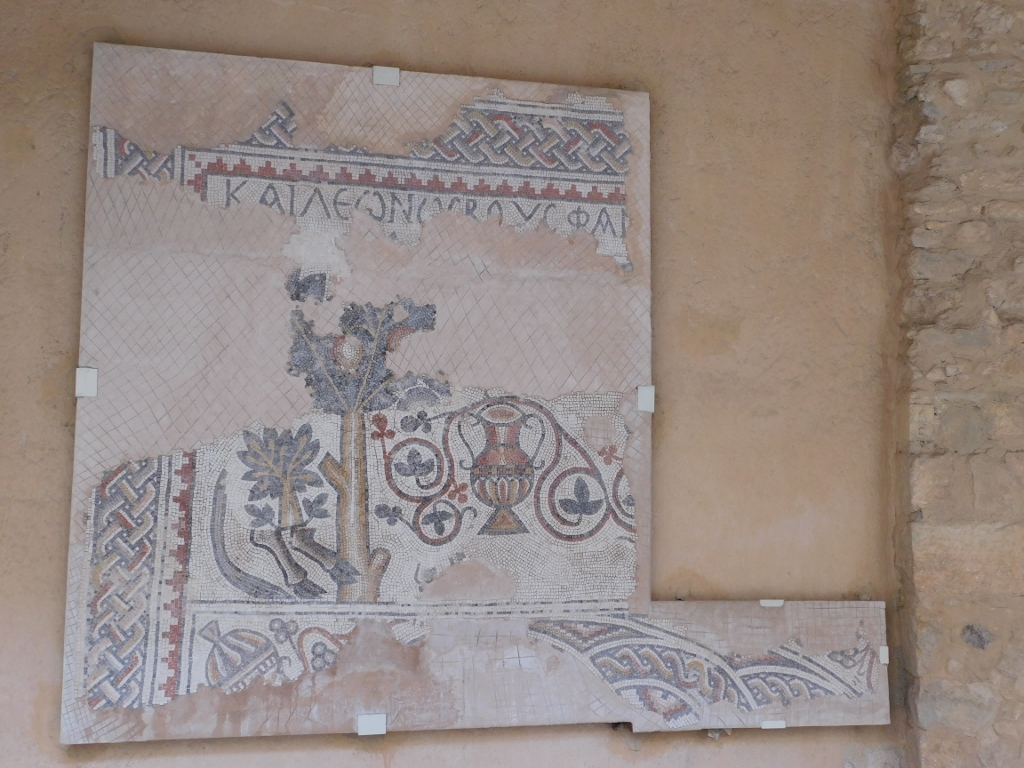 Displayed ancient mosaic from 719/20 CE
Displayed ancient mosaic from 719/20 CE
The mosaic in the photo above is particularly interesting, since on the left-hand side you can see the legs and the tail of an ox whose rest of the body was skilfully removed, while a tree was created in its place. The reason for this is that in the 8th century, the iconoclasm gained the status of the state policy in Byzantium, which meant that depictions of living beings were not acceptable, irrespective of whether they were in icons or, as in this case, within a mosaic.
The mosaic that can be seen in the next photo comes from the same year (719/20 CE) and it shows different cities. What is interesting here is ГАΔОPОN, which is the ancient name of the city of Salt that I visited later during the day.
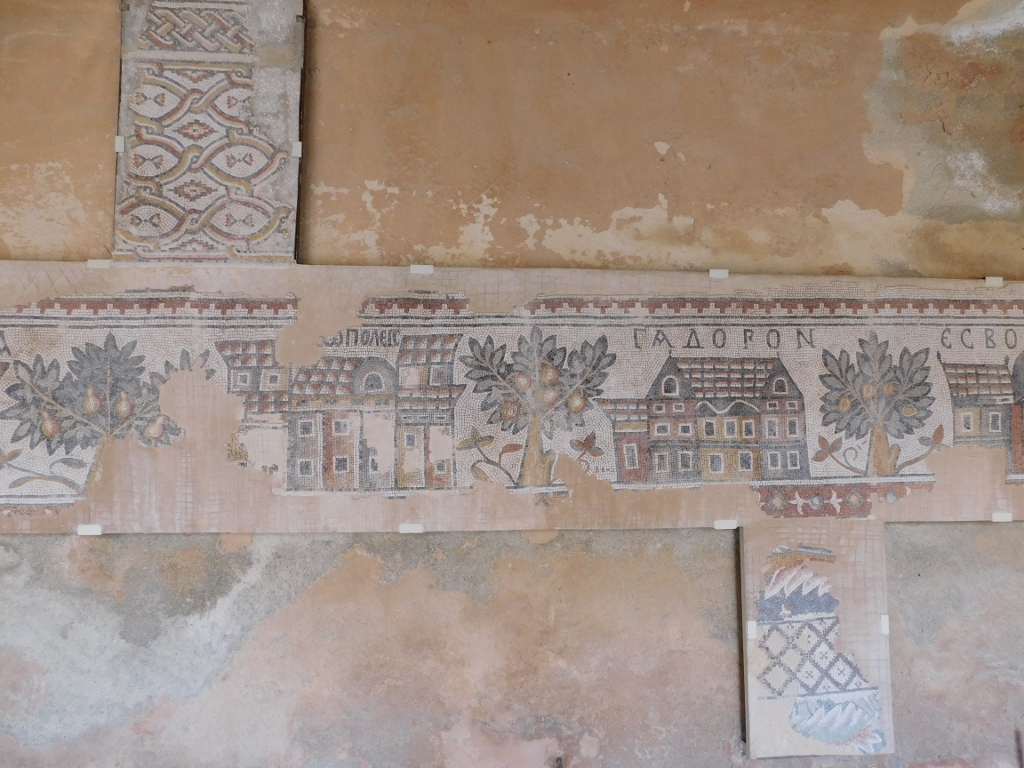 Displayed ancient mosaic
Displayed ancient mosaic
Still, the most impressive segment within the Archaeological Park is the Church of the Virgin and Hippolytus Hall that are practically joined together and nowadays they are covered by a roof in order to protect their remains from rainfall.
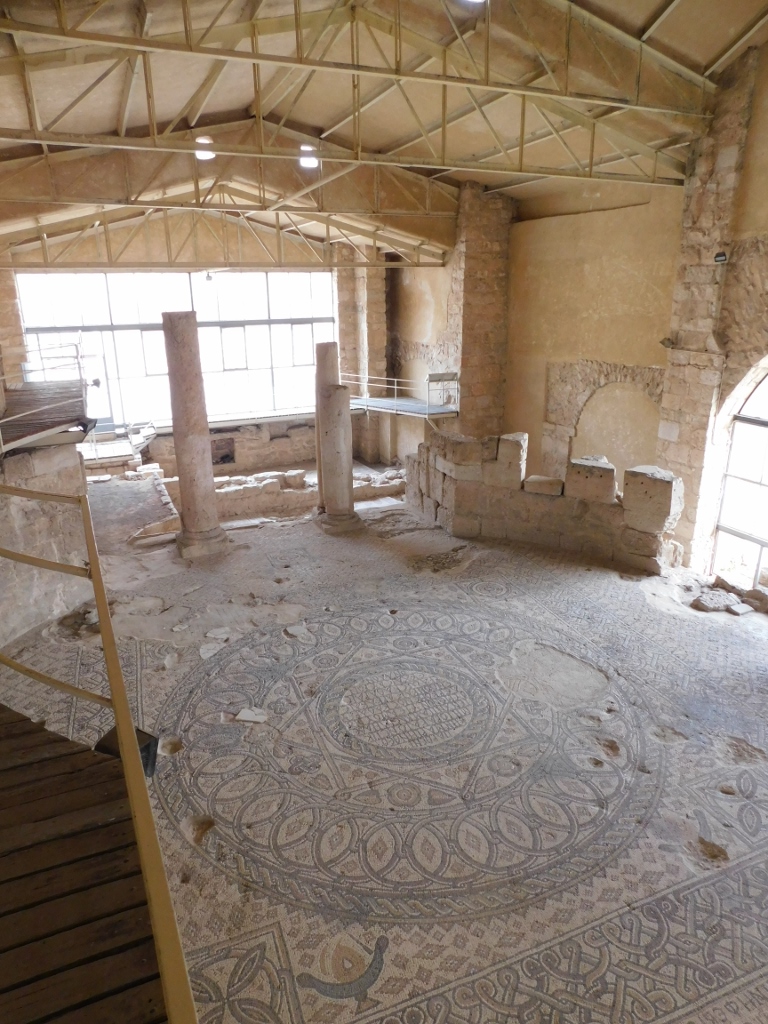 Remains of the church seen towards the entrance (the pillars), while the remains of Hippolytus Hall are at the lower level behind the pillars
Remains of the church seen towards the entrance (the pillars), while the remains of Hippolytus Hall are at the lower level behind the pillars
At the end of the 19th century, a family from Madaba lived here within an old house and then the excavations started and in 1887 the researchers came across a large floor mosaic which was the first floor mosaic from Madaba. Based on a couple of inscriptions, it was concluded that this was the Church of the Virgin. Over time, it has been ascertained that the church was built over a segment of a large ancient mansion in Madaba and that segment is known as Hippolytus Hall, while the mosaic that can be seen there was discovered in 1905. Even that house from the 6th century was in fact built over an older building – a Roman temple.
As for that family that used to live here, they remained in the same place until 1972 and then their property was expropriated, so archaeologists could continue with excavations.
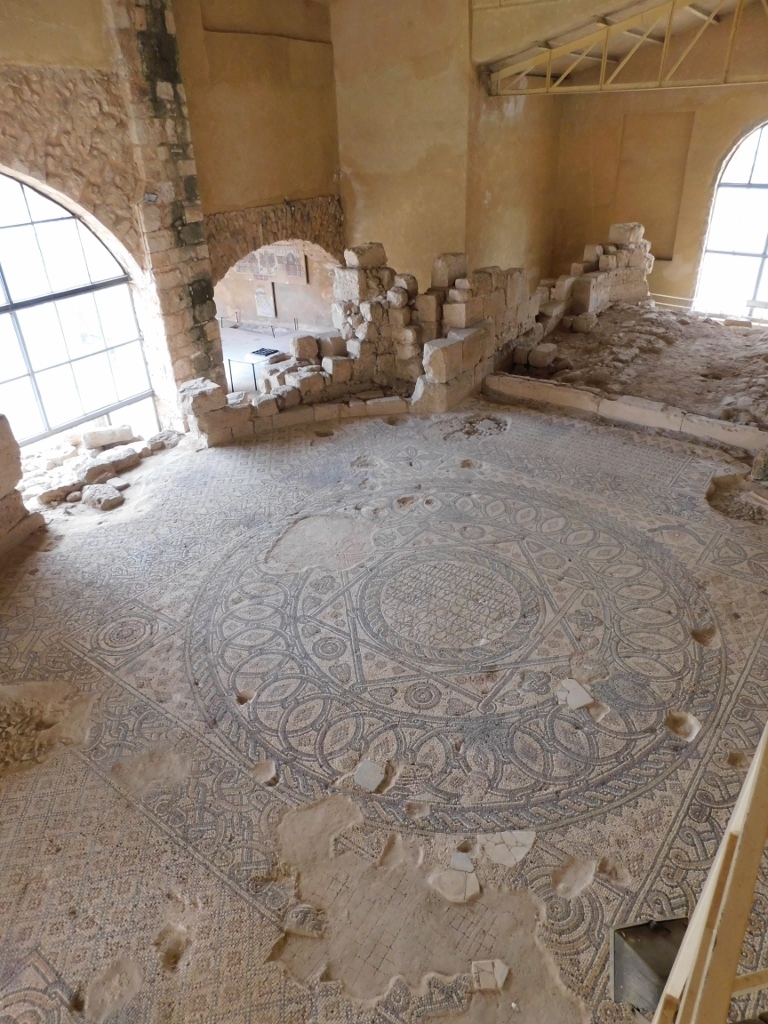 Remains of the church as seen from the platform that runs along the perimeter
Remains of the church as seen from the platform that runs along the perimeter
It is interesting that the impressive floor mosaic which can be seen here is not the original Byzantine mosaic from the 7th century (only some minor segments belong to the original), but rather it is a part of the restoration works carried out on the church during the Umayyad period, i.e., during the 8th century.
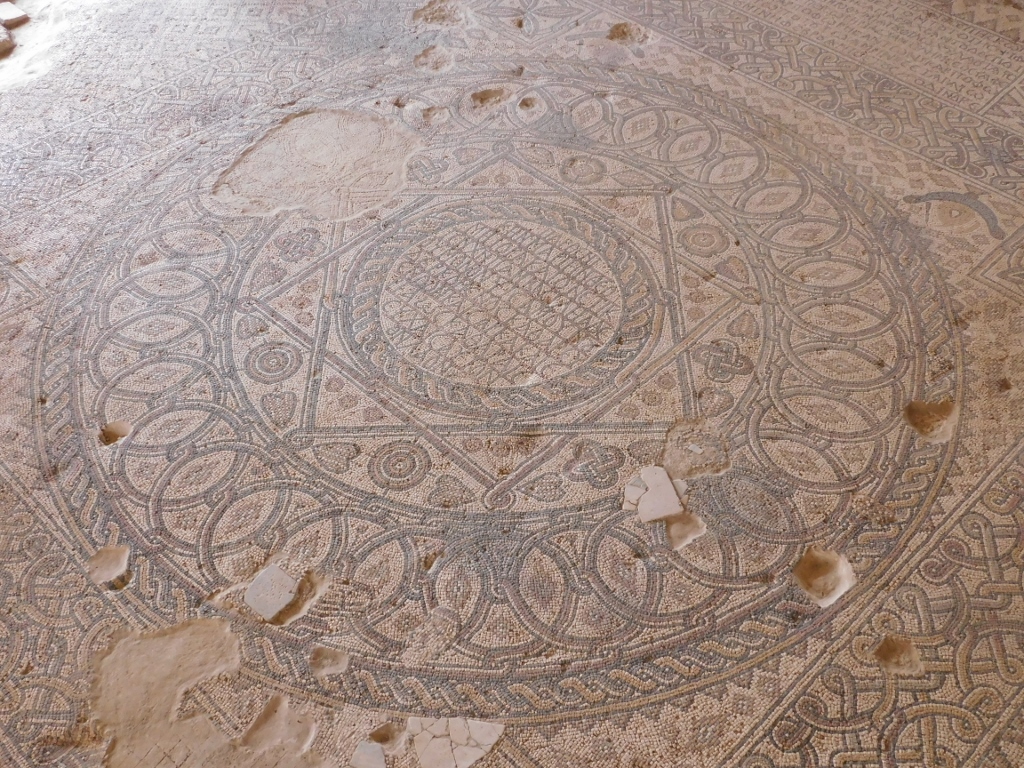 Central part of the floor mosaic from the Church of the Virgin in Madaba
Central part of the floor mosaic from the Church of the Virgin in Madaba
While walking over the fenced platform, I got to Hippolytus Hall. It is presumed that this used to be a part of a sumptuous villa from the beginning of the 6th century that was dismantled some hundred years later in order to build the Church of the Virgin. And yet, under all of these new layers, the original mosaic survived. The mosaic that belongs to Hippolytus Hall is around 1.3 m lower in relation to the level of the church floor.
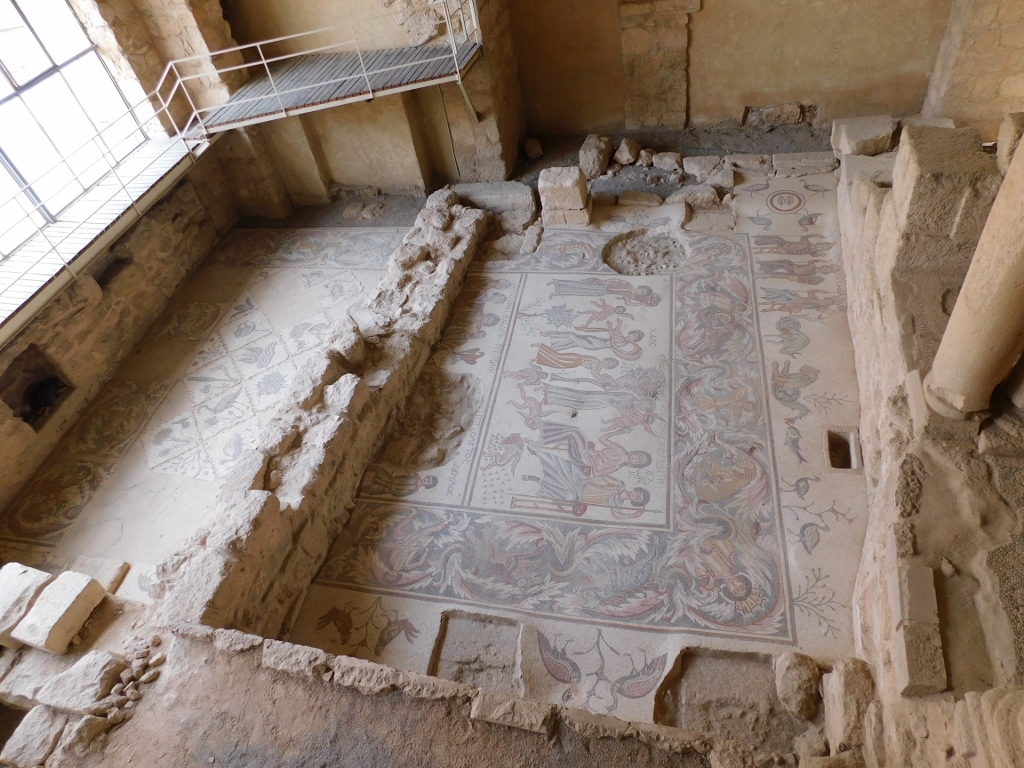 Hippolytus Hall
Hippolytus Hall
As you approach the mosaic by the platform, you can immediately see some interesting parts. Thus, for instance, in each corner there is a depiction of the personification of a different annual season and the first one you come across is Autumn. In the photo above, it is in the lower right-hand corner and here it is again, from up close and under a different angle, shown as a female figure with a crown on her head.
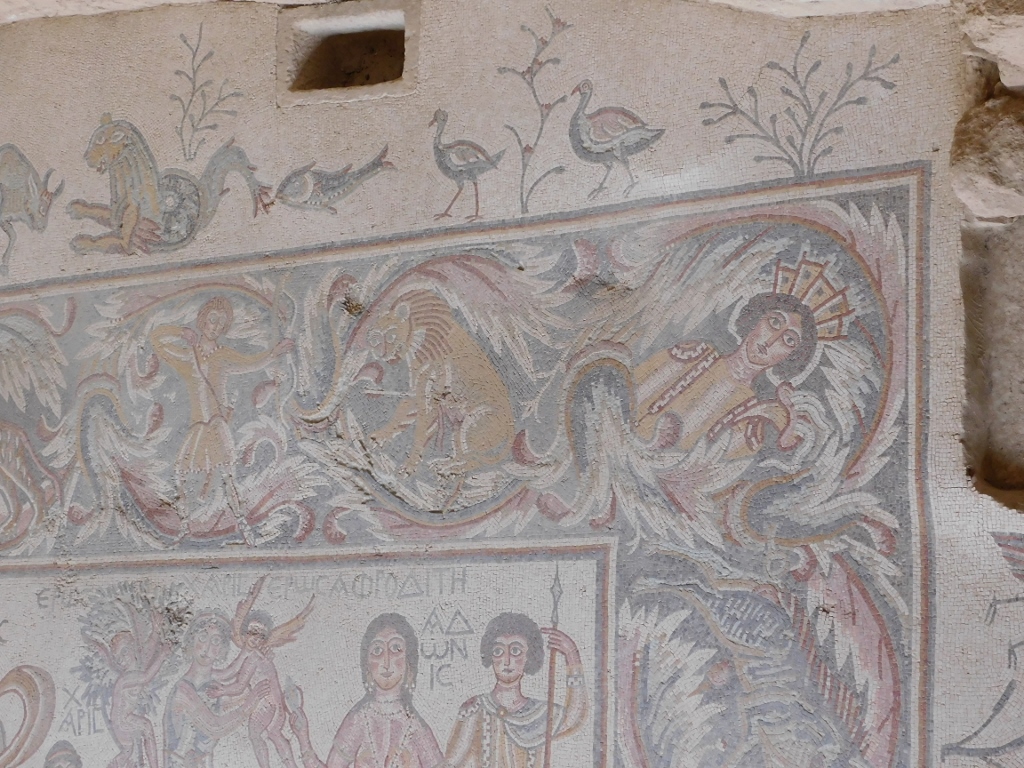 Hippolytus Hall, the personification of Autumn in the right-hand side of the photo
Hippolytus Hall, the personification of Autumn in the right-hand side of the photo
Above the frame in the corner of which Autumn is shown, there are different animals and plants, while on the other end there are personifications of three cities, again in the shape of female figures. These are Rome, Gregoria and Madaba. Below them, in the corner of the frame, there is the personification of Spring.
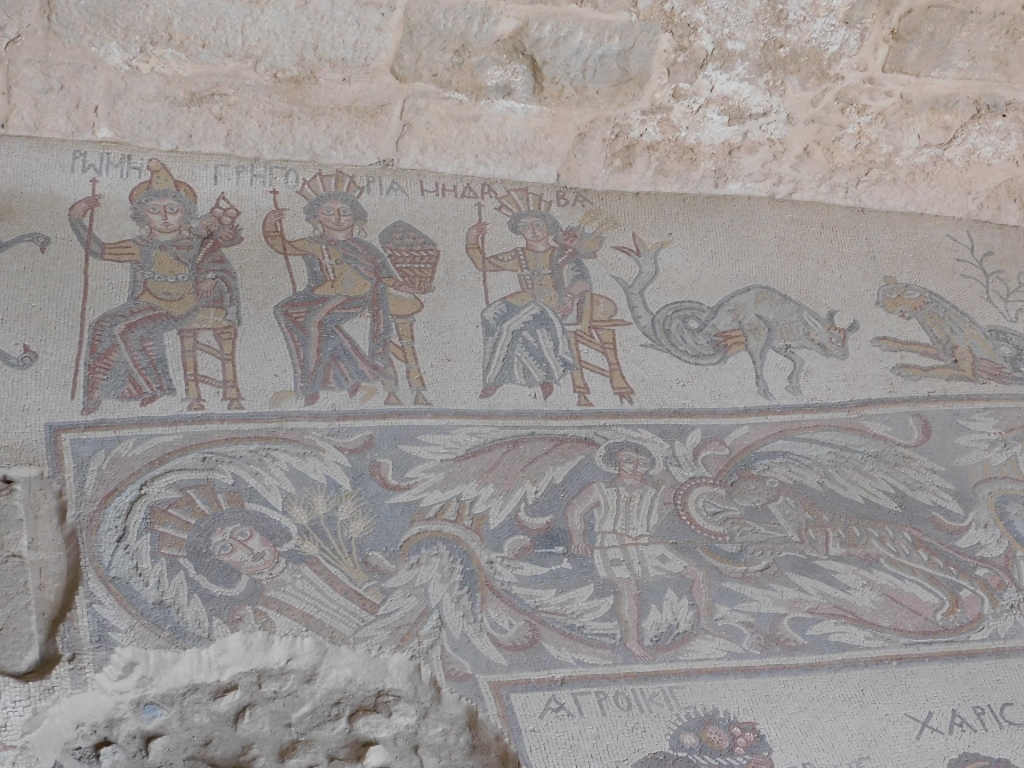 Hippolytus Hall, the personifications of the three cities and Spring
Hippolytus Hall, the personifications of the three cities and Spring
Then I got to the lower segment of this large floor mosaic, that is, this would be the entrance to the hall. Already in the Antiquity, Hippolytus Hall was partitioned by a wall into two rooms, which actually ruined a part of the composition. In the following photo you can see that the floor of the Church of the Virgin is also elevated above the level of Hippolytus Hall.
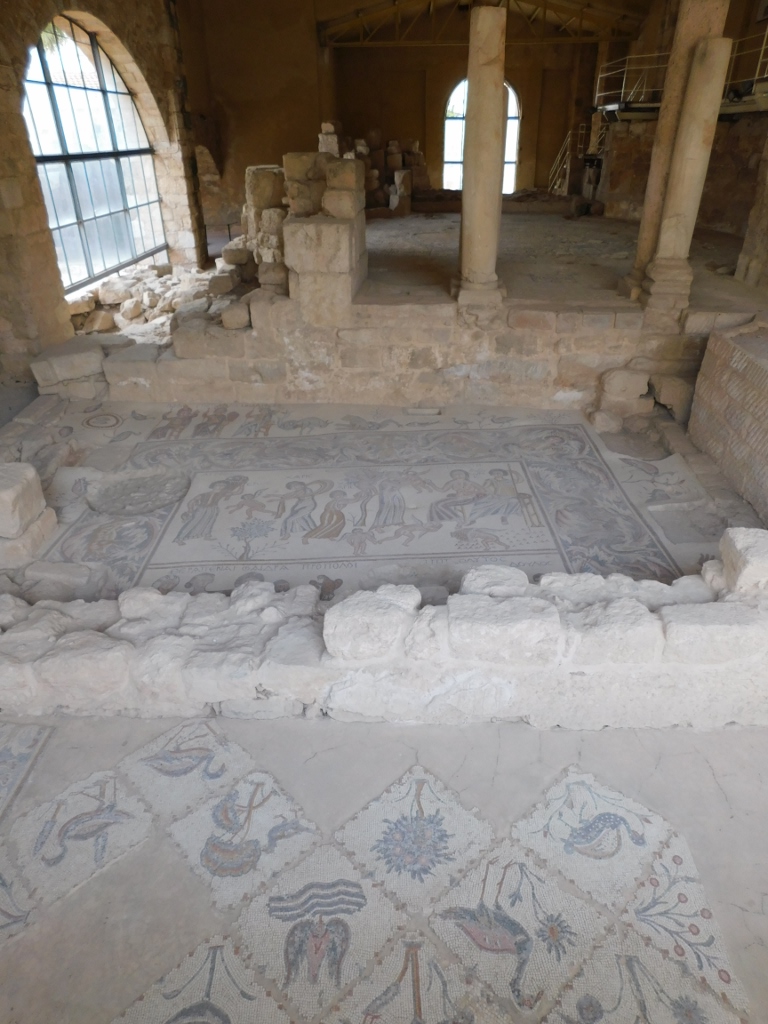 Hippolytus Hall, different parts of the floor
Hippolytus Hall, different parts of the floor
So, in this front part, one can see remains of diamond-shaped fields with depictions of birds and plants, but it is also possible to see a part of the frame of the overall central segment of the mosaic with the depiction of Winter.
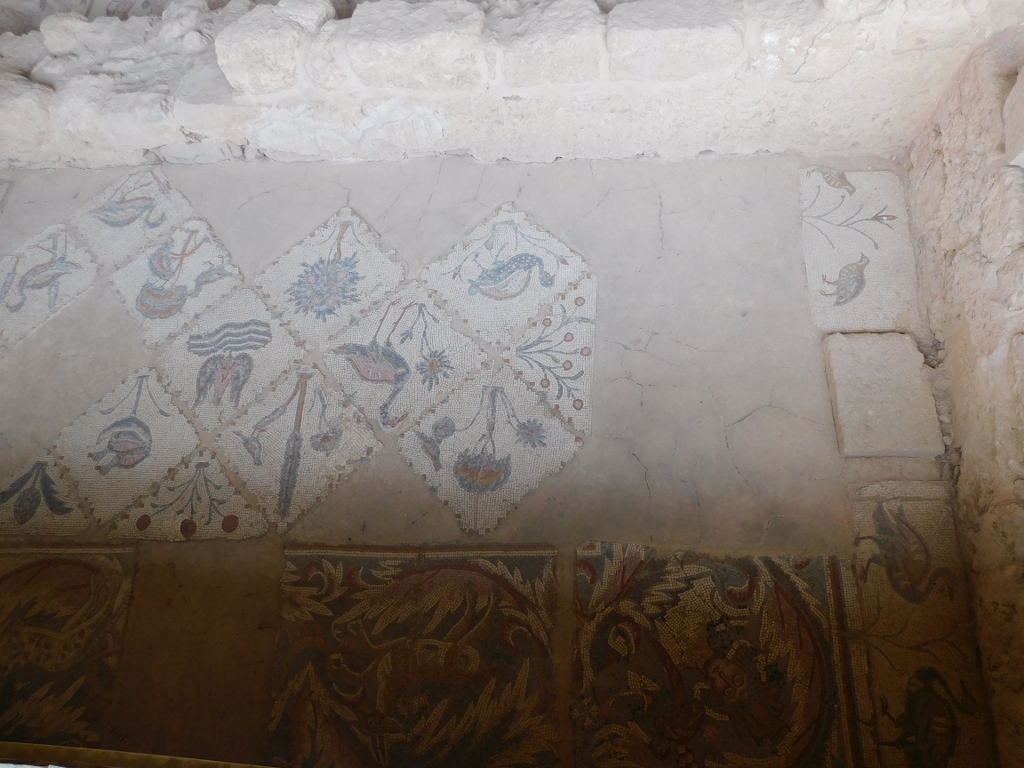 Hippolytus Hall, entrance segment
Hippolytus Hall, entrance segment
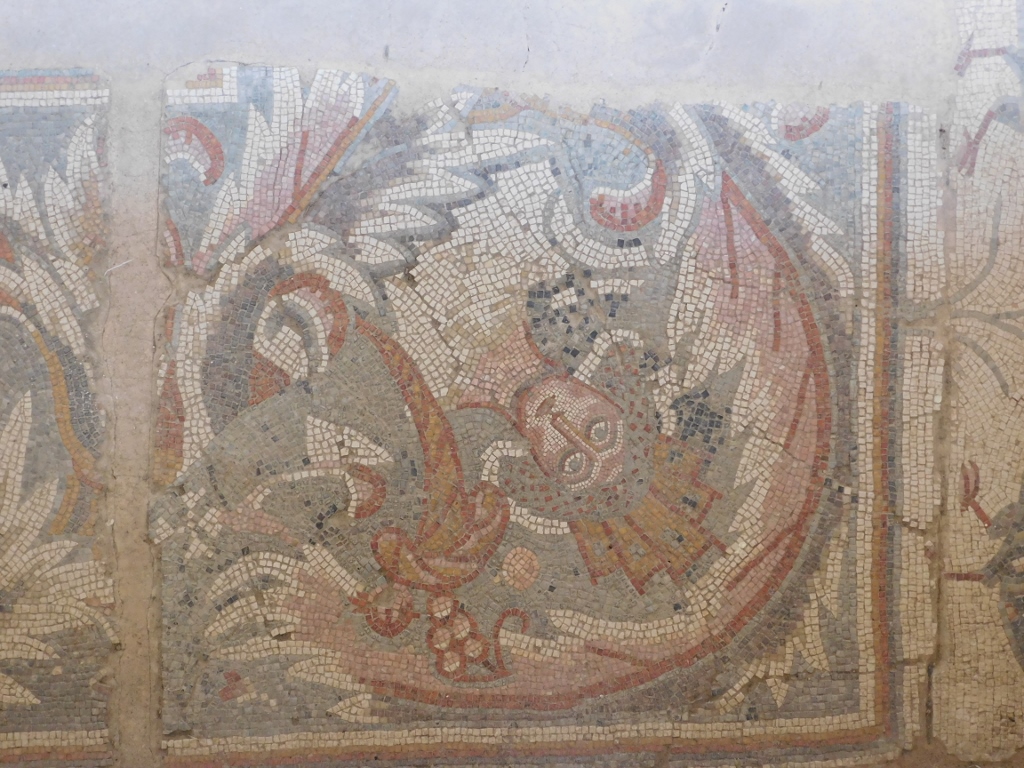 Hippolytus Hall, the personification of Winter
Hippolytus Hall, the personification of Winter
By the way, this part has been named after the main character of Euripides’s tragedy “Hippolytus.” This was the illegitimate son of Theseus and since Hippolytus opted to take side of Artemis, rather than Aphrodite, this latter, vengeful goddess arranged that his step-mother Phaedra fell in love with him, which eventually led to a tragedy. Be as it may, the most important characters from the drama are shown within the mosaic, thus rendering its name.
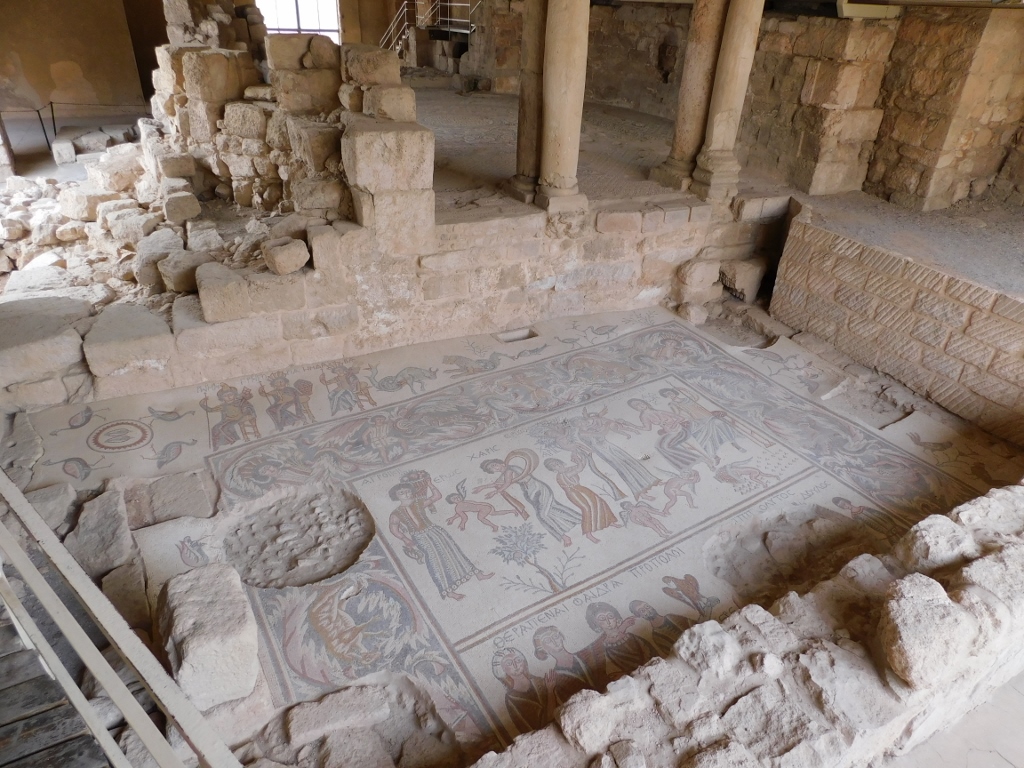 Hippolytus Hall, two main panels with the characters from the tragedy
Hippolytus Hall, two main panels with the characters from the tragedy
In the upper panel, close to the partition wall, there is an image of Phaedra (with her name written above her head), followed by two handmaidens and in the company of a falconer, expecting news of Hippolytus. The image of Hippolytus has been destroyed over time and only his written name can be seen.
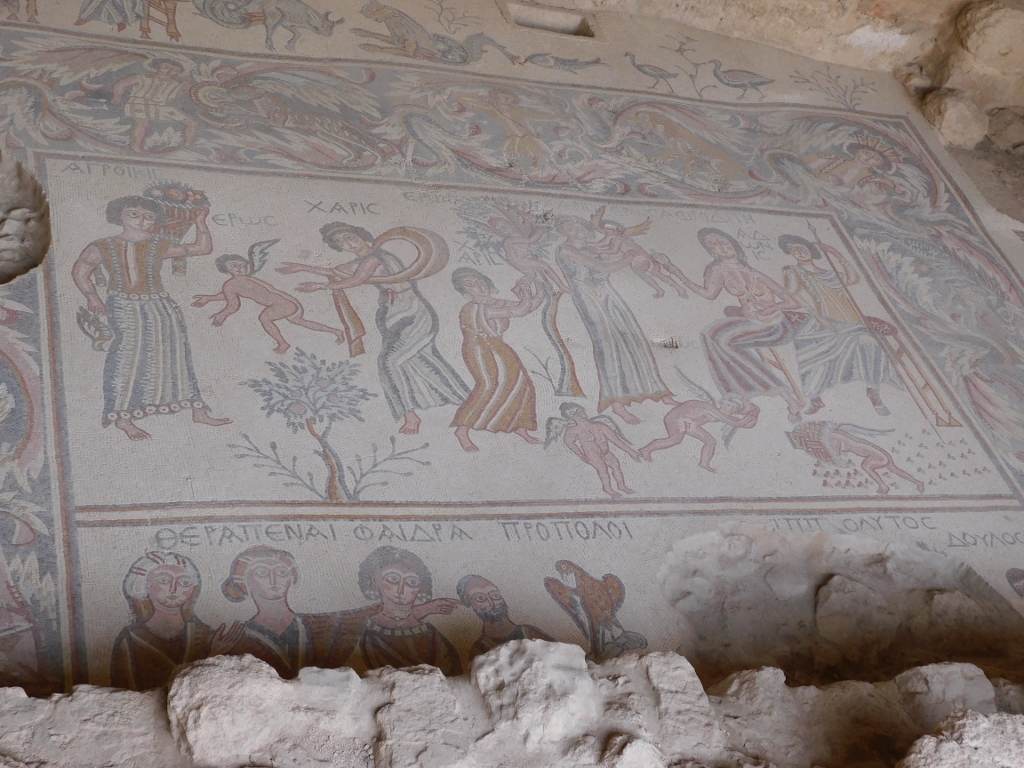 Hippolytus Hall, two main panels with the characters from the tragedy
Hippolytus Hall, two main panels with the characters from the tragedy
In the upper section, the scene is complete and very interesting. On the right-hand side Aphrodite is sitting next to Adonis holding a lance. One of the three Graces is holding Cupid in her arms, whom Aphrodite is spanking with a sandal on its naked bottom. It seems that the whole depiction shows several mischievous Cupids giving headache to the adults. Two other Graces are chasing these naughty children, one of them (all the way down to the right) dived head on into a flower basket scattering the flowers all over the place, while on the left-hand side there is a servant girl carrying a fruit basket and a partridge.
Within the Archaeological Park there is also a part of a Roman street that has survived to the present times. In the following photo you can see the paved street below the level of a contemporary street (you can see a car there).
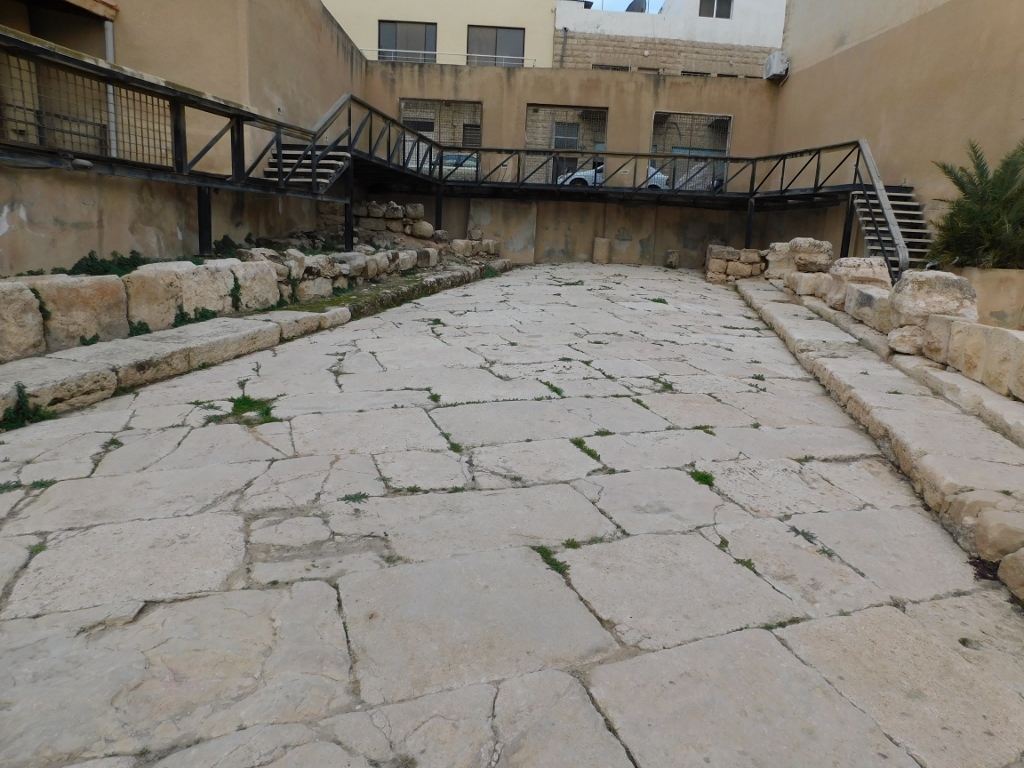 Roman street
Roman street
I found it particularly nice that along the street there are remains of a canal used for the transportation of water.
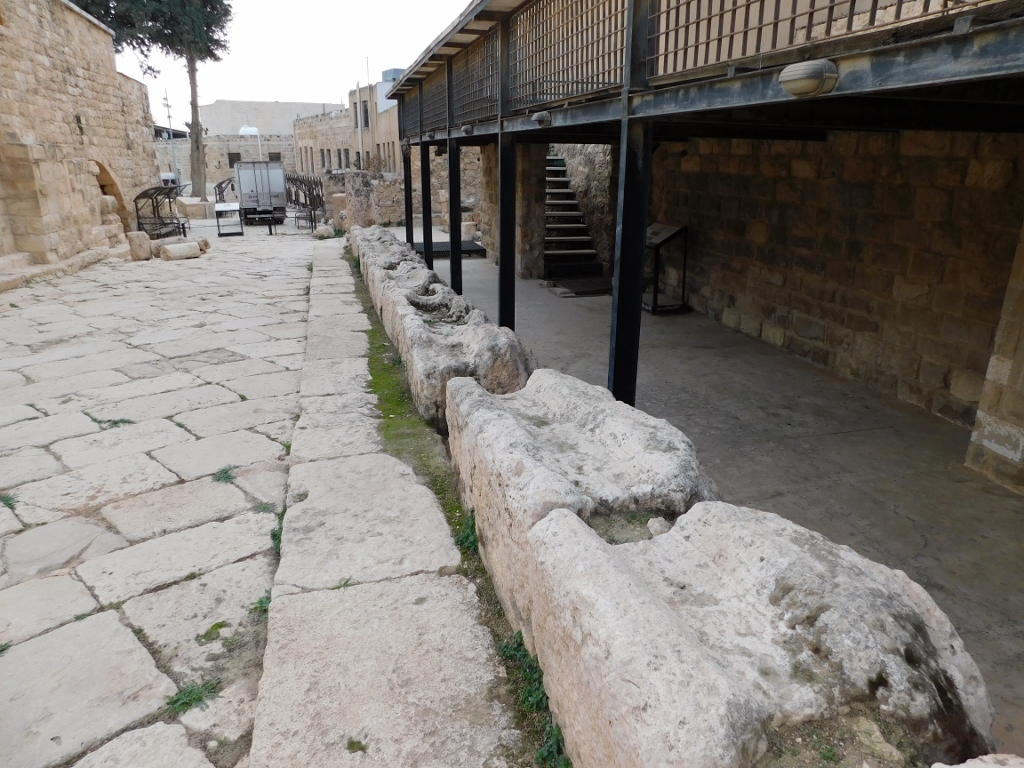 Roman street, a detail
Roman street, a detail
On the other side of the Roman street, the visitor enters the Crypt of Saint Elianus located under the destroyed Church of Prophet Elias. The crypt holds fine mosaics from the end of the 6th century.
 Crypt of Saint Elianus
Crypt of Saint Elianus
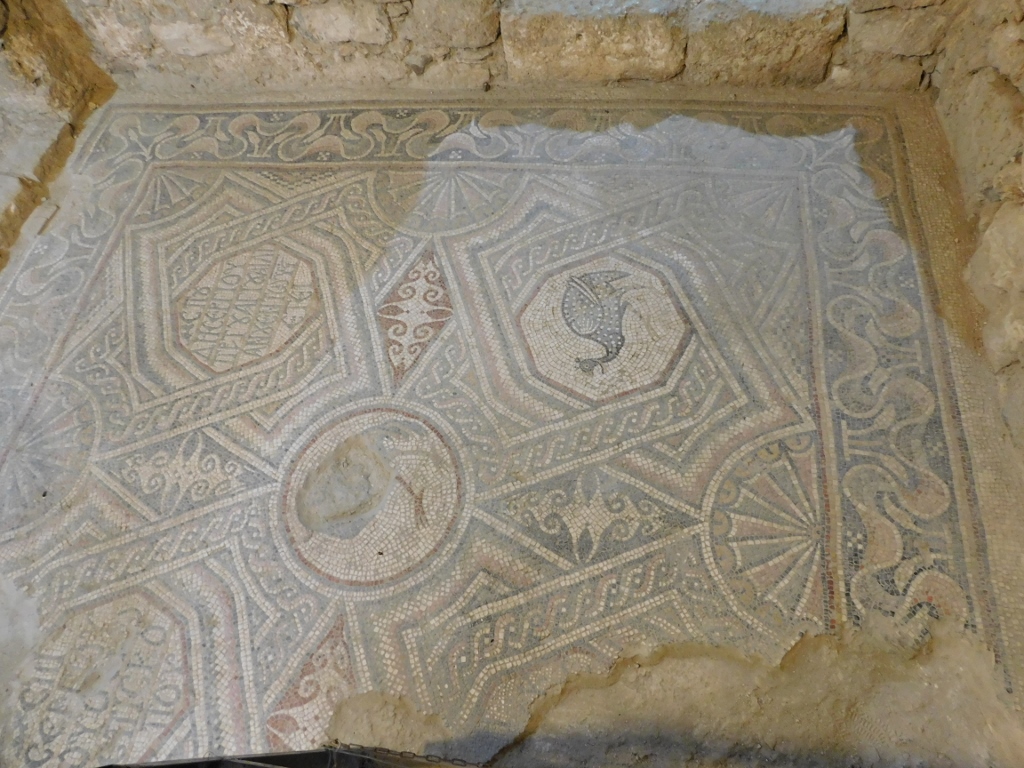 Crypt of Saint Elianus, floor mosaic
Crypt of Saint Elianus, floor mosaic
And here I finished with my visit to the Archaeological Park in Madaba, but it needs to be pointed out that this was only one of two such parks here.
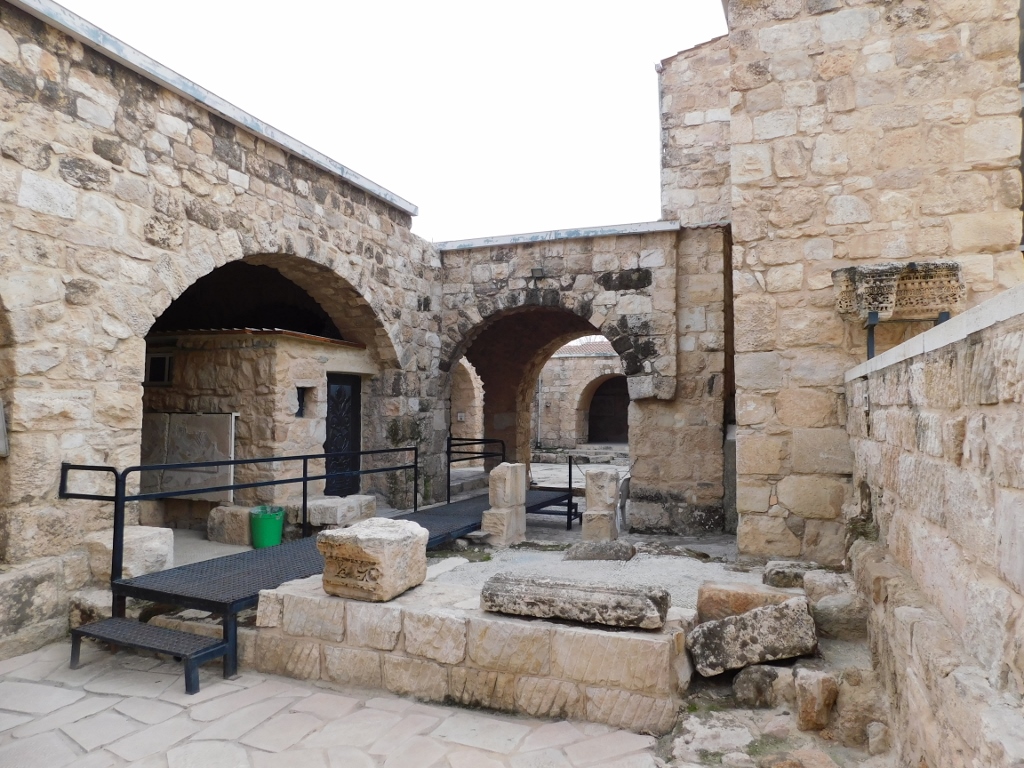 Archaeological Park 1
Archaeological Park 1
So, I walked to the nearby Archaeological Park 2. Within this part, there are two important structures. The first one is the so-called Burnt Palace, that is, remains of a luxurious villa built at the end of the 6th century and the beginning of the 7th century.
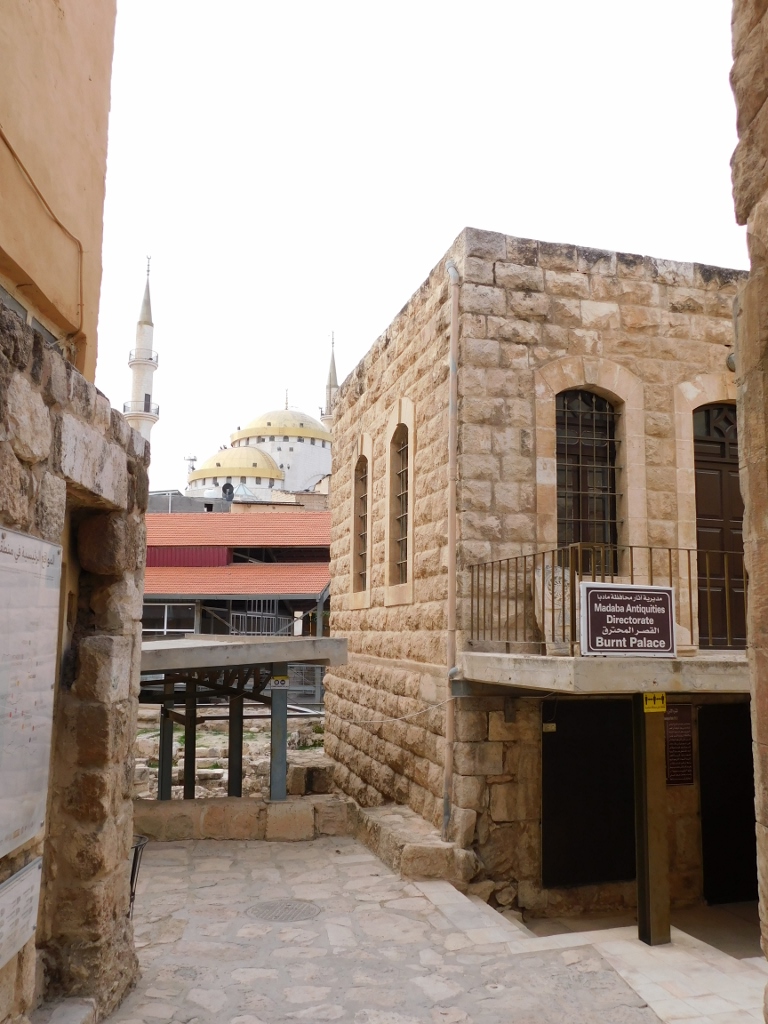 Archaeological Park 2, access to the Burnt Palace
Archaeological Park 2, access to the Burnt Palace
The building got its name because it was destroyed in a blaze and it is presumed that this took place in the 8th century. Still, some parts of the Byzantine mosaics have survived.
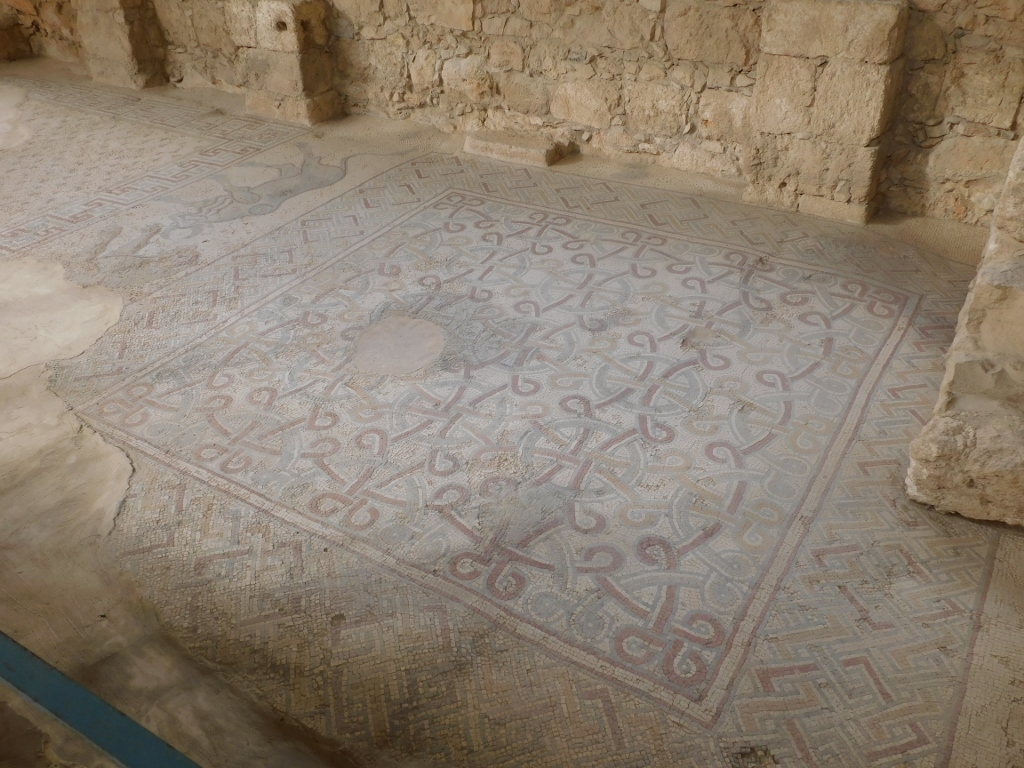 Burnt Palace
Burnt Palace
The mosaics are protected by a structure today and following a platform along it one gets to the central part of the archaeological park.
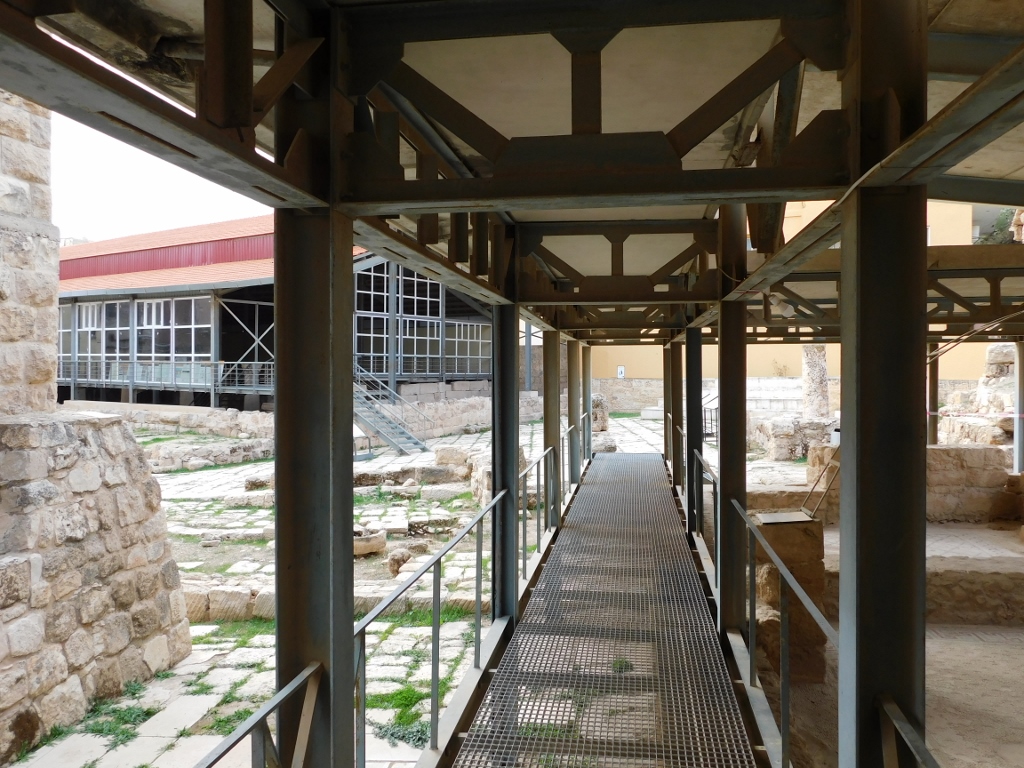 Protective structure, the platform and the remains of the Burnt Palace on the right-hand side of the photo
Protective structure, the platform and the remains of the Burnt Palace on the right-hand side of the photo
When I got to Archaeological Park 2, I first came across the Burnt Palace and so I visited it, but there was nobody to buy a ticket from, so I hesitated a little, looking around, not quite sure if I should proceed with my visit. Then I heard some voices and went in that direction. As it turned out they did not have the tickets at the moment, so I was told I could continue with my sightseeing and we would see about the ticket later. And so I went back to the central part of the park where I wanted to visit the largest structure, but its entrance gate was locked. I was about to head back when I saw one of the guards walking my way and then he unlocked the gate. I could finally visit the Church of the Holy Martyrs.
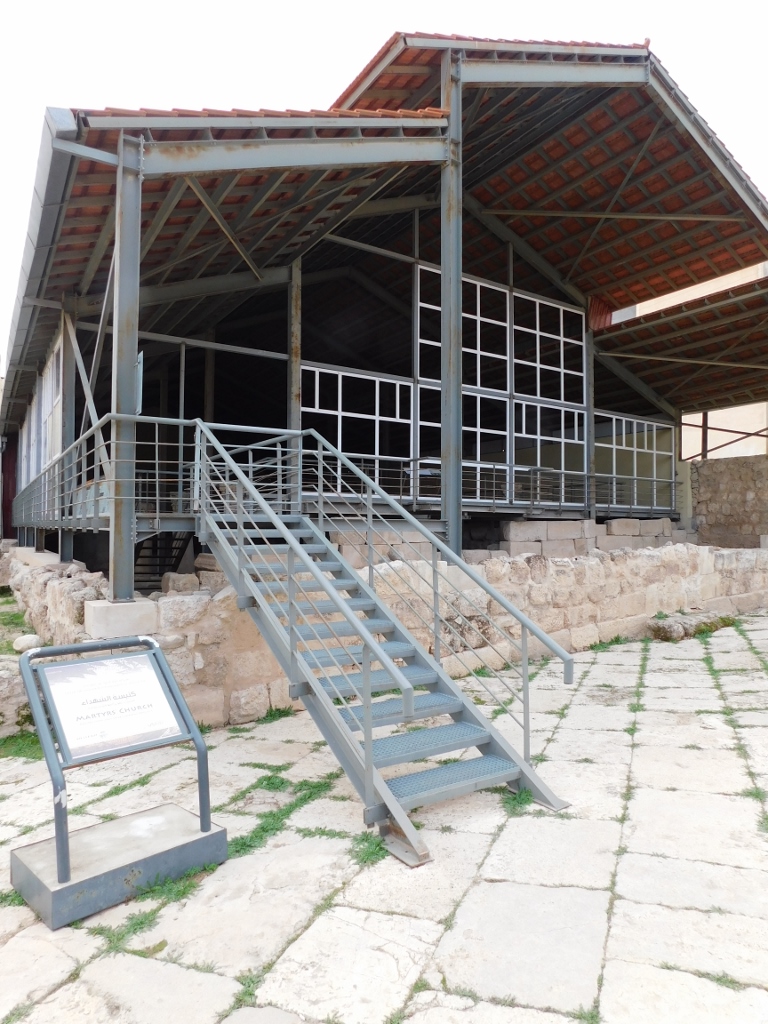 Covered remains of the Church of the Holy Martyrs
Covered remains of the Church of the Holy Martyrs
In front of this church that was built in the 6th century, there are remains of a paved Roman street and this can also be seen in the photo above.
The base of the church is 32 x 16 m and originally it used to have three entrances in the front façade. When one climbs the stairs it is possible to see how truly large this space is and one can also see an impressive floor mosaic (unfortunately, only the remains).
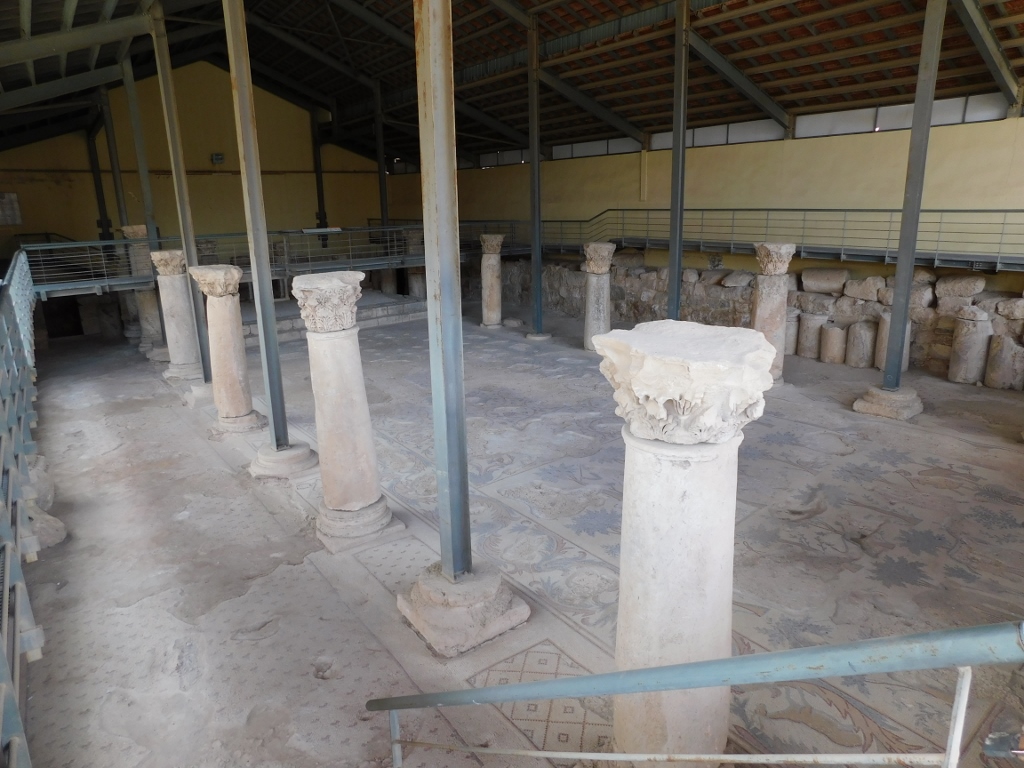 Church of the Holy Martyrs
Church of the Holy Martyrs
Although there are mosaics in the remains of the aisles, it is precisely the central nave that is particularly impressive. If you look a little better, you can see in the front section of the nave a large panel that shows different scenes in four rows. However, it is interesting that most of the images of humans have been removed. Although there were damages made during the excavations, the main reason for this state is the iconoclasm that became omnipresent in Byzantium at some point.
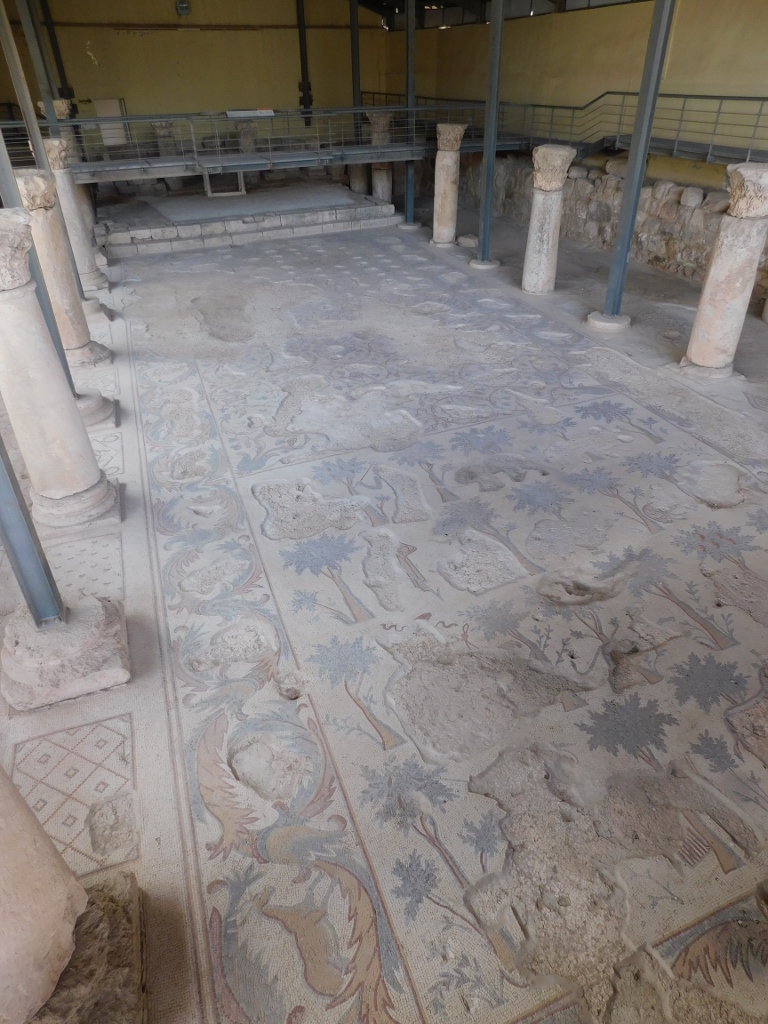 Church of the Holy Martyrs, mosaic in the central nave
Church of the Holy Martyrs, mosaic in the central nave
Still, enough has remained for the archaeologists to be able to interpret certain scenes. Thus, in the photo below, one can see a camel that is being held by a rope by a hunter.
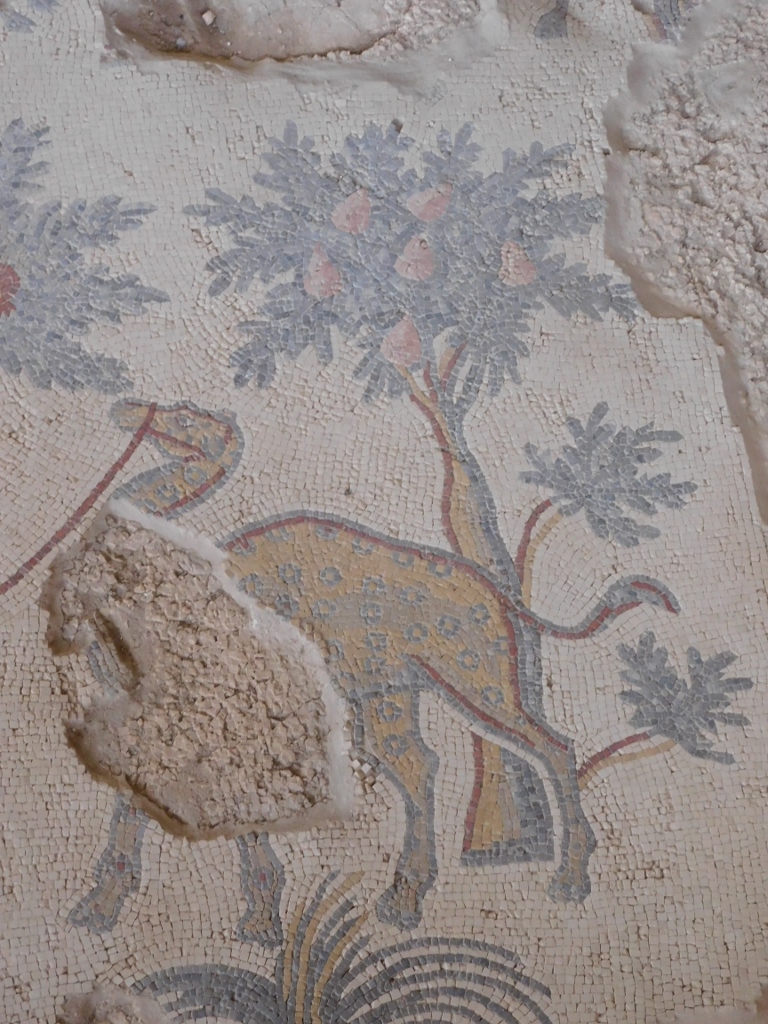 Church of the Holy Martyrs, mosaic, a detail
Church of the Holy Martyrs, mosaic, a detail
In the back of the church, where the apse is, you can see a synthronon for which the material had been taken from older Roman buildings.
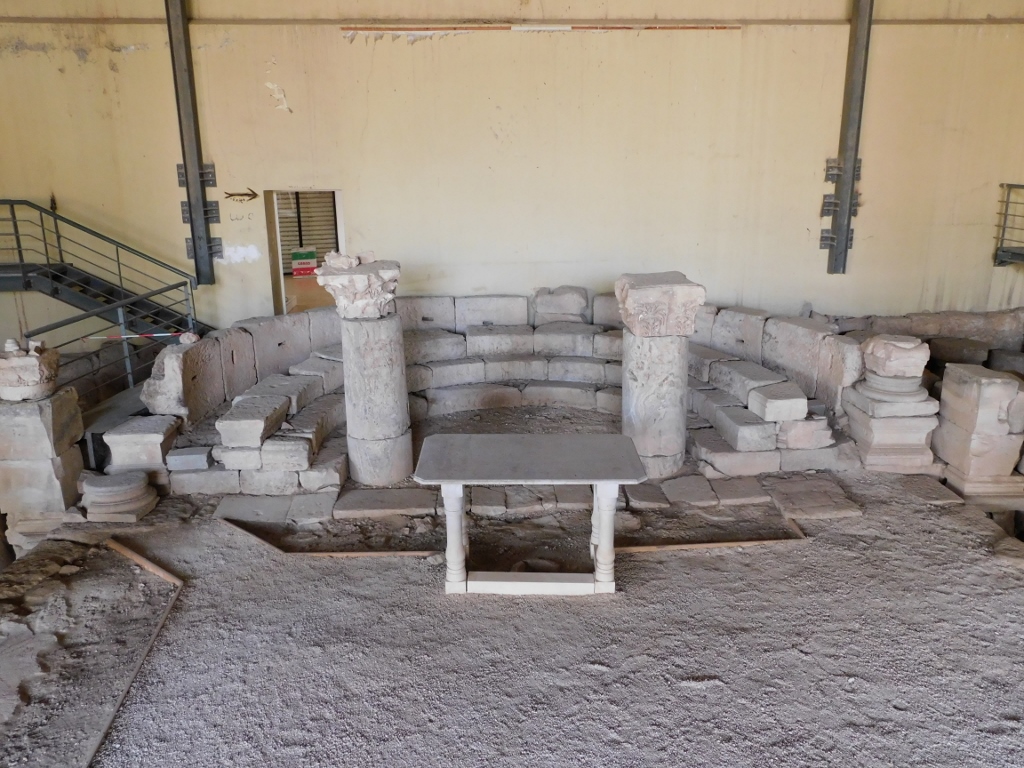 Church of the Holy Martyrs, the apse
Church of the Holy Martyrs, the apse
But only when you get here and look towards the entrance, you can see the real scale of the damages to the floor mosaic, although this does not diminish by any means the strong impression made by the whole monument.
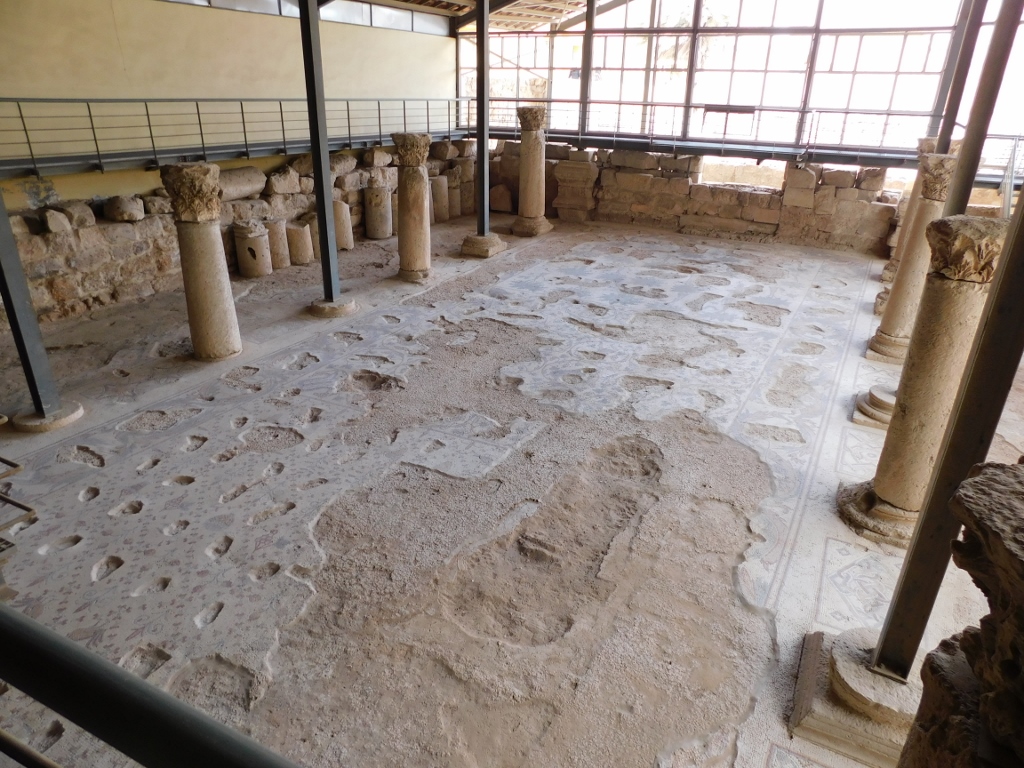 Church of the Holy Martyrs, damages to the mosaic in the main nave
Church of the Holy Martyrs, damages to the mosaic in the main nave
When I finished with this visit as well (without the bought ticket, since the deal was that I should pay for it at the next place, since the ticket actually covers three sites), I realised I was quite short with time, bearing in mind my agreement with the driver. In Madaba I wanted to visit the Apostles Church, too, and I first headed that way on foot, but it became clear soon enough that I would not make it. So, I went back to the car and told the young man driving me this day that we should make a stop at yet another place in Madaba before we move on. He looked at me expressionlessly and said that all the tourists want to see only the Church of St. George and that this is enough for them. It was now my turn to look at him back expressionlessly, while saying in a serious voice: “But, I am not a tourist, I am a traveller.” And then I silently died laughing.
So, we drove to the Apostles Church that is in fact located right beside the King’s Highway passing through Madaba. This motorway follows an ancient trade route that was of vital importance for the Near East, for it used to connect Egypt and Mesopotamia.
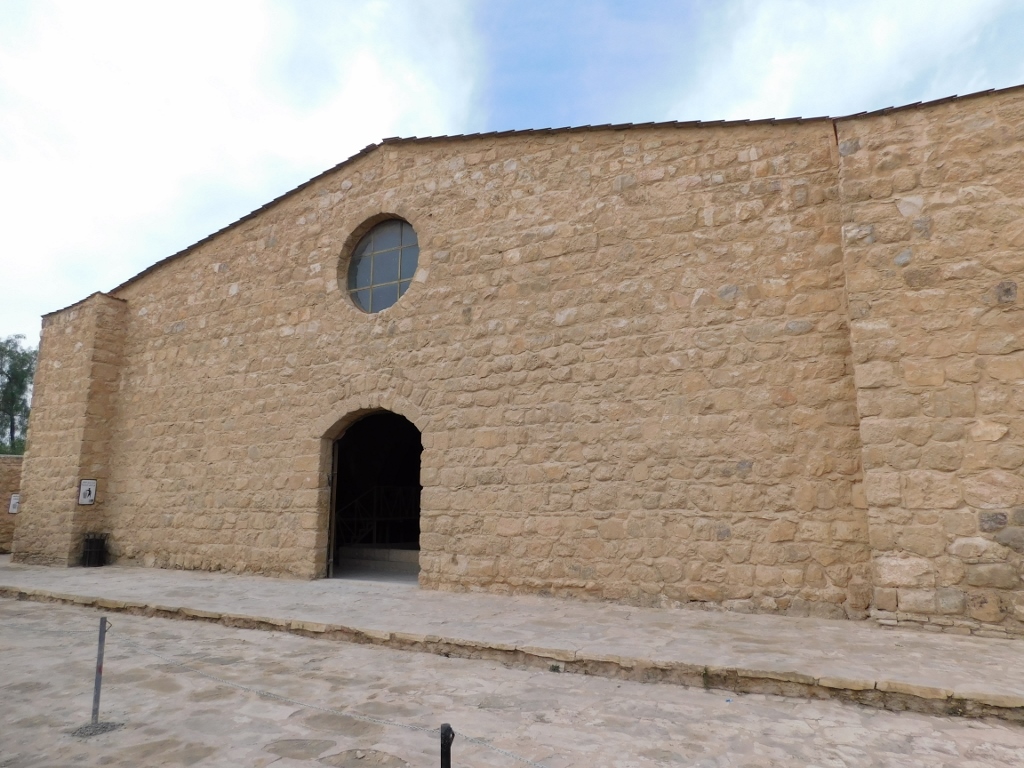 Apostles Church
Apostles Church
The structure that can be seen here is a contemporary building that also serves to protect the remains found here in 1902. A priest who found these remains belonging to a church also came across the name of the church (subsequently destroyed), as well as the year of the construction (578 CE). Here, too, there is a large area covered in mosaics. When you look up the images of these mosaics on the internet, the colours are significantly more vivid than what I came across. The internet photos were probably taken soon after a fresh “scrubbing of the floor,” while in my case they also show a large quantity of dust.
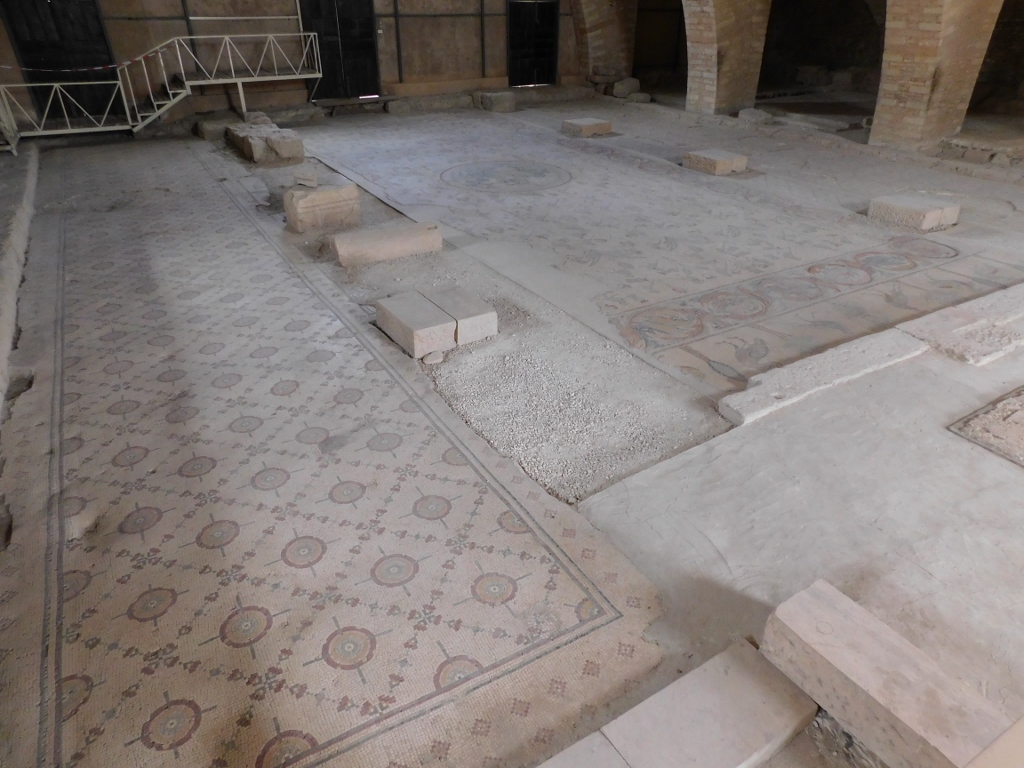 Apostles Church, the interior
Apostles Church, the interior
Here, too, there is a path over an elevated platform that allows for a better view at the mosaics, taking into account the large surface area of the floor, but this also helps grasp the entire space better.

The floor of the church, luckily, avoided destruction by iconoclasts. Most of the mosaic shows birds and plants, but the most important and the most beautiful part is the central medallion with the diameter of 2.2 metres showing the personification of the Sea (in the shape of deity Thalassa).
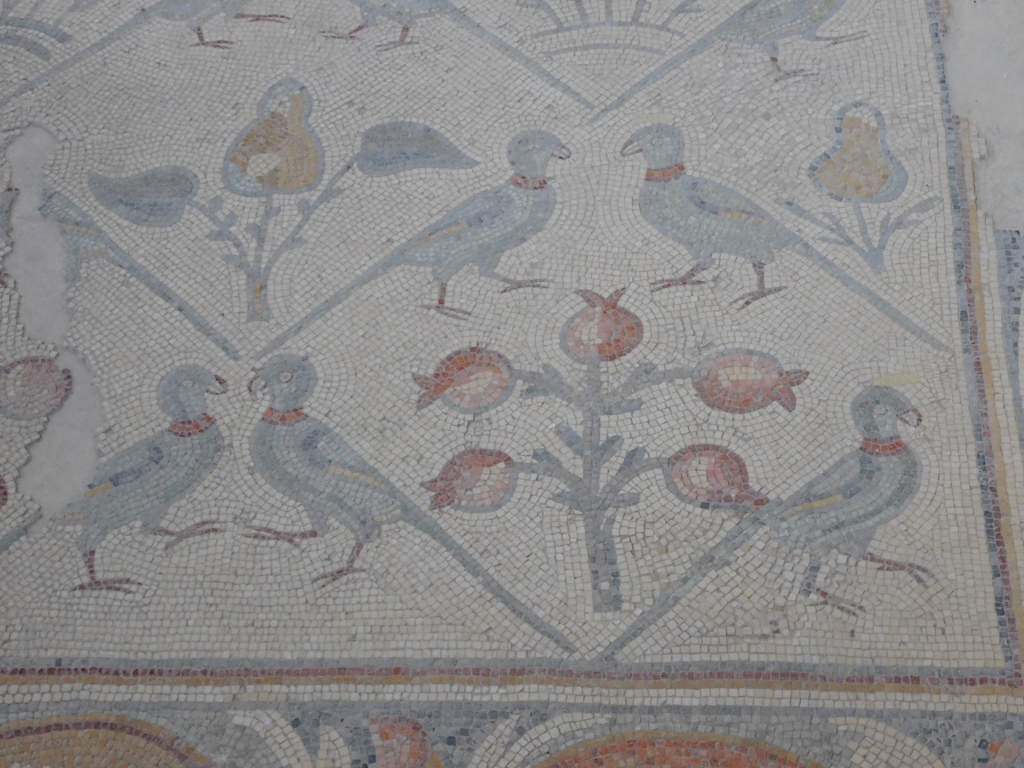 Apostles Church, mosaic details
Apostles Church, mosaic details
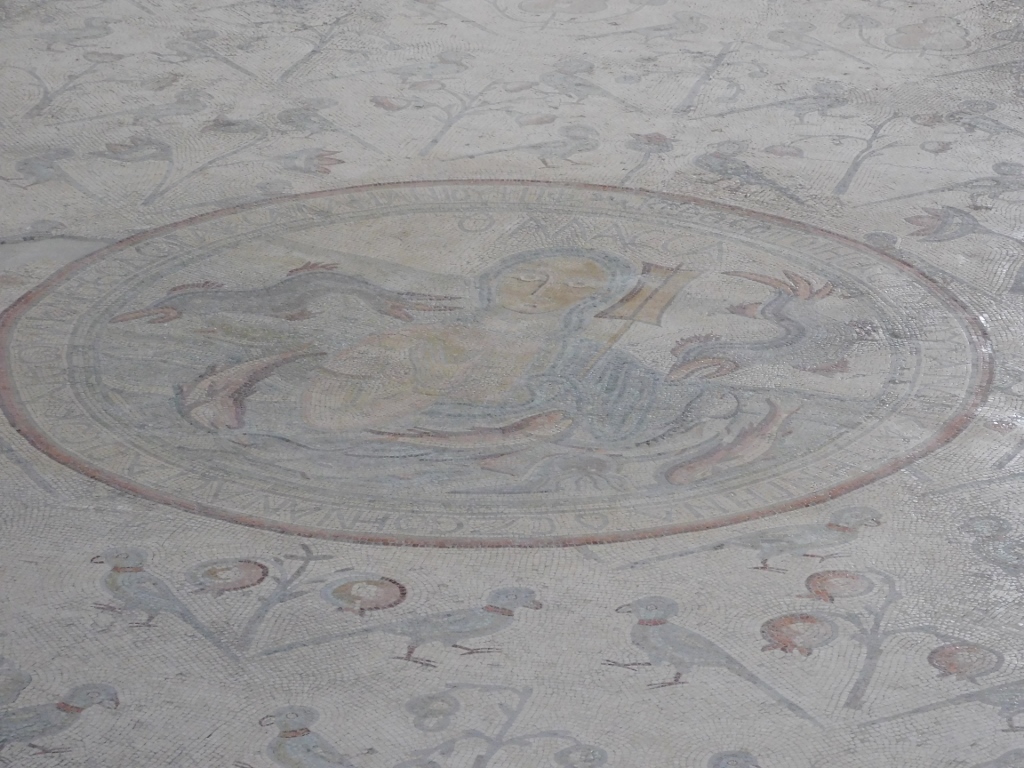 Apostles Church, central medallion
Apostles Church, central medallion
What with the dust and the distance, the above photo is pale and not too clear, but it is still possible to discern a female figure surrounding by swimming fish, sharks, sea creatures, as well as an octopus.
With this I finished with my sightseeing of Madaba and its mosaics. It would have been nice if I had had more time for walking around the town on my own, but I did have to move on and the next stop was Mount Nebo.
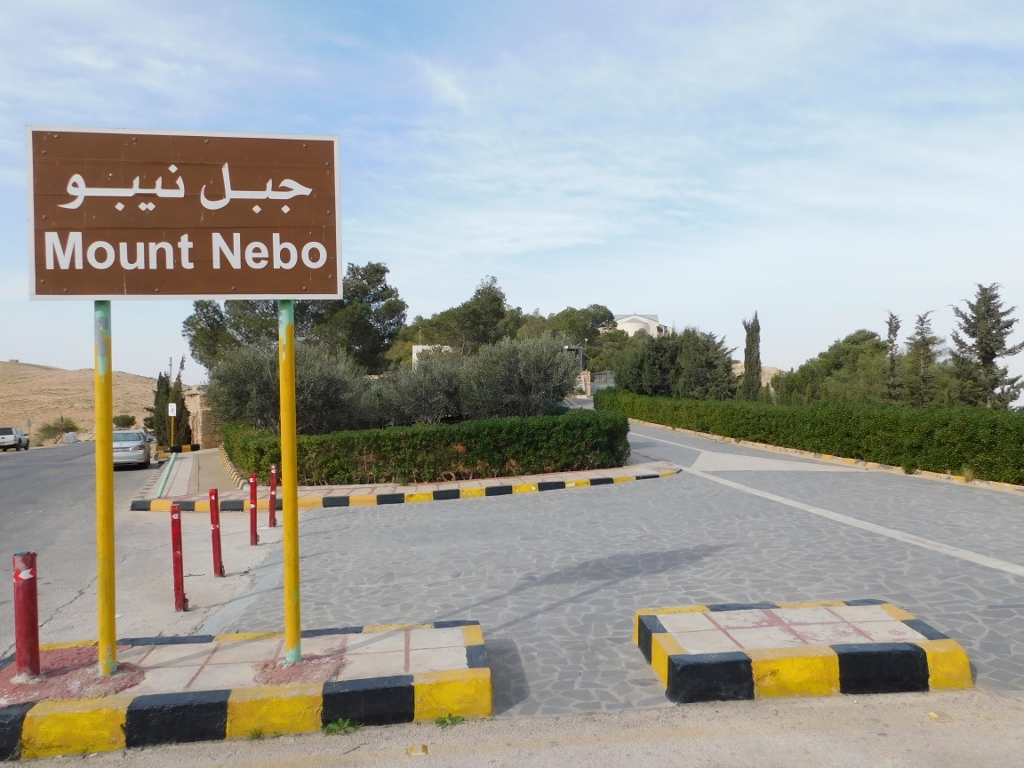 Mount Nebo
Mount Nebo
Here, on the top, there is a memorial built on the site from which, according to the tradition, after 40 years of wandering in the desert, Moses saw the Promised Land. He also died here at the age of 120. This is what the tradition says. Moses is a very important figure in Judaism, as well as in Christianity and in Islam (being considered a prophet), which makes this site one of the holiest in Jordan. Over time, there have been archaeological excavations, but no mortal remains have been found, as expected (and hoped for) by the Jews and Christians, while the Muslims believe that his body would be transferred and buried somewhere else.
Be as it may, it is presumed that the first building here was constructed during the classical times, but already by the year 394 CE this building was converted into a church. Later, there was also an active monastic community here, but this was all abandoned by 1564 turning into ruins with time. In 1933, Franciscans bought the site and today it is them who take care of this area.
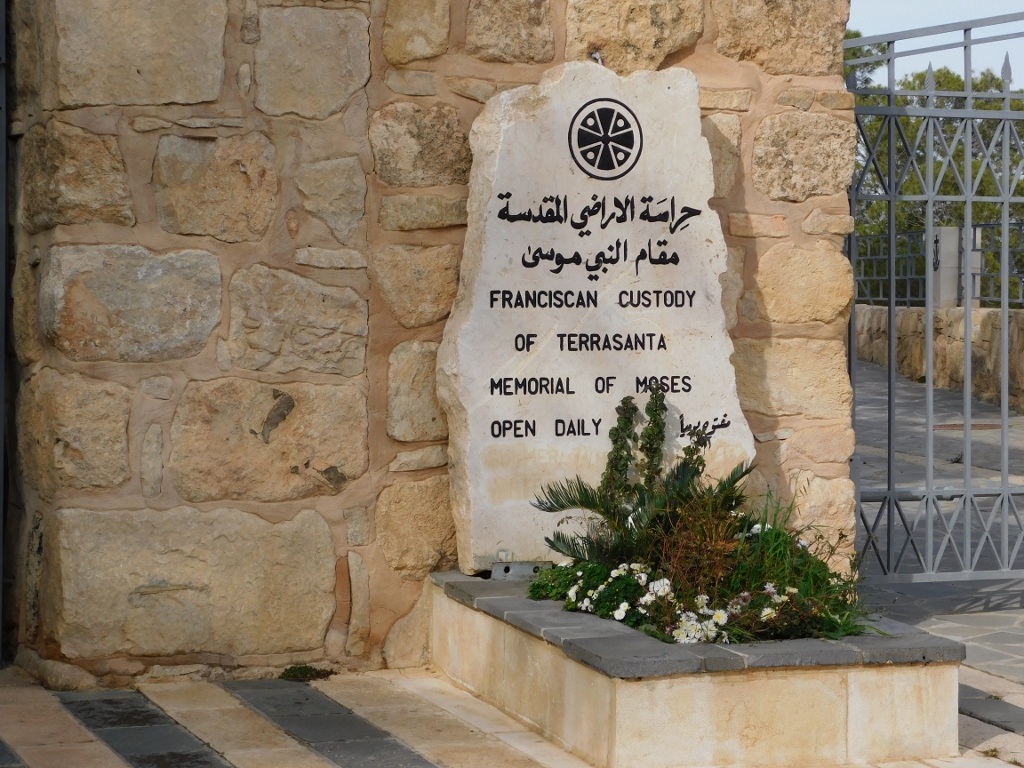 Mount Nebo, entrance to the site
Mount Nebo, entrance to the site
When leaving the ticket office and walking up along a very mild slope, the visitor first comes across the Book of Love among Nations Monument and a little farther away a stone marker that emphasises once again what this is all about.
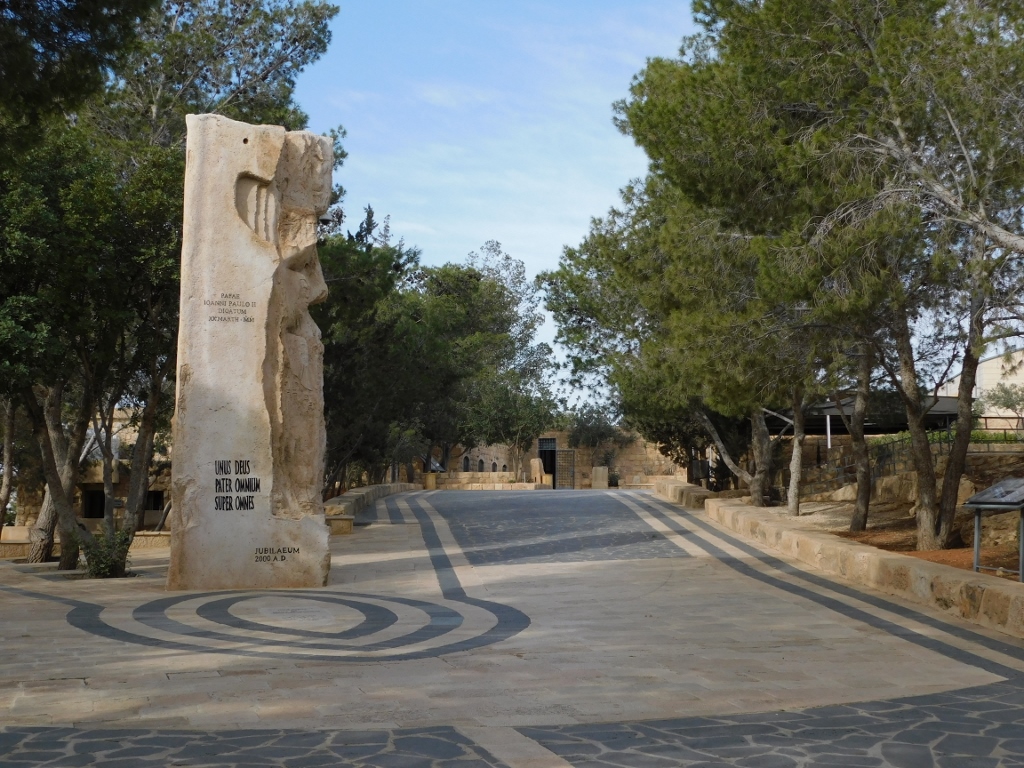 Mount Nebo, approaching the site
Mount Nebo, approaching the site
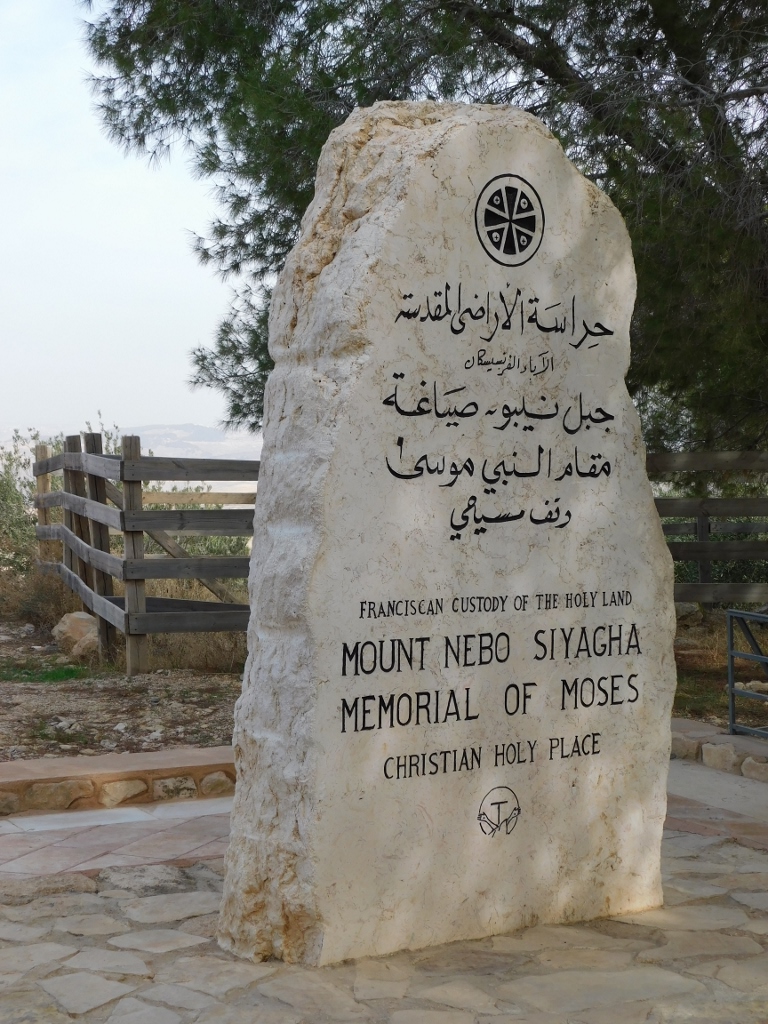 Mount Nebo, stone marker
Mount Nebo, stone marker
Already here it is possible to go to the side and have a look at the surrounding area, but from this place one can have only a partial look at the Promised Land. The relevant viewpoint is somewhat farther away, in front of a new church built on the top that can be seen on the left-hand side of the photo below.
